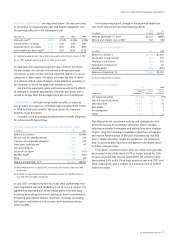GE 2007 Annual Report Download - page 73
Download and view the complete annual report
Please find page 73 of the 2007 GE annual report below. You can navigate through the pages in the report by either clicking on the pages listed below, or by using the keyword search tool below to find specific information within the annual report.
ge 2007 annual report 71
For larger oil drilling equipment projects and long-term construc-
tion projects, we recognize sales based on our progress towards
contract completion measured by actual costs incurred in relation
to our estimate of total expected costs. We measure SOP 81-1
revenues by applying our contract-specifi c estimated margin rates
to incurred costs. We routinely update our estimates of future
costs for agreements in process and report any cumulative effects
of such adjustments in current operations. We provide for any
loss that we expect to incur on these agreements when that loss
is probable.
We recognize revenue upon delivery for sales of aircraft
engines, military propulsion equipment and related spare parts
not sold under long-term product services agreements. Delivery
of large and small commercial engines, non-U.S. military equip-
ment and all related spare parts occurs on shipment; delivery of
military propulsion equipment sold to the U.S. Government or
agencies thereof occurs upon receipt of a Material Inspection
and Receiving Report, DD Form 250. Large commercial engines
(CF6, CFM56, GE90, GEnx and GP7000) are complex aerospace
equipment manufactured to customer order under a variety of
sometimes-complex, long-term agreements. We measure sales
of large commercial engines by applying our contract-specifi c
estimated margin rates to incurred costs. We routinely update our
estimates of future costs for large commercial engine agreements
in process and report any cumulative effects of such adjustments
in current operations. We measure revenue for small aircraft
engines, military propulsion equipment and spare parts not
subject to long-term product services agreements based on the
specifi c contract on a specifi cally-measured output basis, although
no faster than ratably. We provide for any loss that we expect to
incur on these agreements when that loss is probable; consistent
with industry practice, for commercial engines, we make such
provision only if such losses are not recoverable from future
highly probable sales of spare parts for those engines.
We sell product services under long-term agreements in
our Infrastructure segment, principally Aviation, Energy and
Transportation, where costs of performing services are incurred
on other than a straight-line basis. We also sell product services
in Healthcare, where such costs are expected to be on a straight-
line basis. All of these agreements are accounted for under
Financial Accounting Standards Board (FASB) Technical Bulletin
(FTB) 90-1, Accounting for Separately Priced Extended Warranty
and Product Maintenance Contracts. For the Infrastructure
FTB 90-1 agreements, we recognize related sales based on the
extent of our progress towards completion measured by actual
costs incurred in relation to total expected costs. We routinely
update our estimates of future costs for agreements in process
and report any cumulative effects of such adjustments in current
operations. For the Healthcare FTB 90-1 agreements, we recognize
revenues on a straight-line basis and expense related costs as
incurred. We provide for any loss that we expect to incur on any
of these agreements when that loss is probable.
NBC Universal records broadcast and cable television and
Internet advertising sales when advertisements are aired, net of
provision for any viewer shortfalls (make goods). We record sales
from theatrical distribution of fi lms as the fi lms are exhibited;
sales of home videos, net of a return provision, when the videos
are delivered to and available for sale by retailers; fees from cable/
satellite operators when services are provided; and licensing of
fi lm and television programming when we make the material
available for airing.
GECS revenues from services (earned income)
We use the interest method to recognize income on all loans.
Interest on loans includes origination, commitment and other
non-refundable fees related to funding (recorded in earned
income on the interest method). We stop accruing interest at the
earlier of the time at which collection of an account becomes
doubtful or the account becomes 90 days past due. We recognize
interest income on nonearning loans either as cash is collected
or on a cost-recovery basis as conditions warrant. We resume
accruing interest on nonearning, non-restructured commercial
loans only when (a) payments are brought current according to
the loan’s original terms and (b) future payments are reasonably
assured. When we agree to restructured terms with the borrower,
we resume accruing interest only when reasonably assured that
we will recover full contractual payments, and such loans pass
underwriting reviews equivalent to those applied to new loans.
We resume accruing interest on nonearning consumer loans
when the customer’s account is less than 90 days past due.
We recognize fi nancing lease income on the interest method
to produce a level yield on funds not yet recovered. Estimated
unguaranteed residual values at the date of lease inception
represent our initial estimates of the fair value of the leased
assets at the expiration of the lease and are based primarily on
independent appraisals, which are updated periodically. Guarantees
of residual values by unrelated third parties are considered part
of minimum lease payments. Signifi cant assumptions we use in
estimating residual values include estimated net cash fl ows over
the remaining lease term, anticipated results of future remarket-
ing, and estimated future component part and scrap metal
prices, discounted at an appropriate rate.
We recognize operating lease income on a straight-line basis
over the terms of underlying leases.
Fees include commitment fees related to loans that we do
not expect to fund and line-of-credit fees. We record these fees
in earned income on a straight-line basis over the period to
which they relate. We record syndication fees in earned income
at the time related services are performed, unless signifi cant
contingencies exist.
























